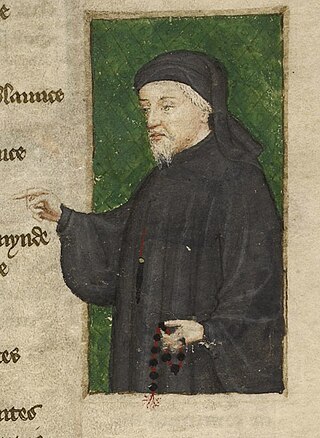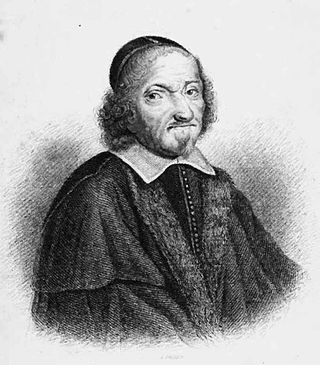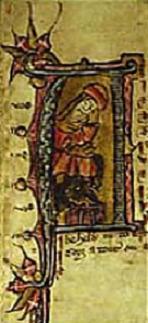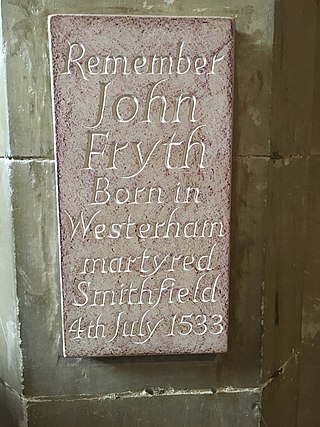Related Research Articles

Geoffrey Chaucer was an English poet, author, and civil servant best known for The Canterbury Tales. He has been called the "father of English literature", or, alternatively, the "father of English poetry". He was the first writer to be buried in what has since come to be called Poets' Corner, in Westminster Abbey. Chaucer also gained fame as a philosopher and astronomer, composing the scientific A Treatise on the Astrolabe for his 10-year-old son Lewis. He maintained a career in the civil service as a bureaucrat, courtier, diplomat, and member of parliament.
William Tyndale was an English biblical scholar and linguist who became a leading figure in the Protestant Reformation in the years leading up to his execution. He is well known as a translator of the Bible into English, and was influenced by the works of prominent Protestant Reformers such as Martin Luther.

Myles Coverdale, first name also spelt Miles, was an English ecclesiastical reformer chiefly known as a Bible translator, preacher and, briefly, Bishop of Exeter (1551–1553). In 1535, Coverdale produced the first complete printed translation of the Bible into English. His theological development is a paradigm of the progress of the English Reformation from 1530 to 1552. By the time of his death, he had transitioned into an early Puritan, affiliated to Calvin, yet still advocating the teachings of Augustine.

John Rogers was an English clergyman, Bible translator and commentator. He guided the development of the Matthew Bible in vernacular English during the reign of Henry VIII and was the first English Protestant executed as a heretic under Mary I of England, who was determined to restore Roman Catholicism.

The Matthew Bible, also known as Matthew's Version, was first published in 1537 by John Rogers, under the pseudonym "Thomas Matthew". It combined the New Testament of William Tyndale, and as much of the Old Testament as he had been able to translate before being captured and put to death. Myles Coverdale translated chiefly from German and Latin sources and completed the Old Testament and Biblical apocrypha, except for the Prayer of Manasseh, which was Rogers', into the Coverdale Bible. It is thus a vital link in the main sequence of English Bible translations.

Piers Plowman or Visio Willelmi de Petro Ploughman is a Middle English allegorical narrative poem by William Langland. It is written in un-rhymed, alliterative verse divided into sections called passus.

William Langland is the presumed author of a work of Middle English alliterative verse generally known as Piers Plowman, an allegory with a complex variety of religious themes. The poem translated the language and concepts of the cloister into symbols and images that could be understood by a layman.
Early Modern English Bible translations are those translations of the Bible which were made between about 1500 and 1800, the period of Early Modern English. This was the first major period of Bible translation into the English language including the King James Version and Douai Bibles. The Reformation and Counter-Reformation led to the need for Bibles in the vernacular with competing groups each producing their own versions.

John Frith was an English Protestant priest, writer, and martyr.
Robert Crowley, was a stationer, poet, polemicist and Protestant clergyman among Marian exiles at Frankfurt. He seems to have been a Henrician Evangelical in favour of a more reformed Protestantism than the king and the Church of England sanctioned. Under Edward VI, he joined a London network of evangelical stationers to argue for reforms, sharing a vision of his contemporaries Hugh Latimer, Thomas Lever, Thomas Beccon and others of England as a reformed Christian commonwealth. He attacked as inhibiting reform what he saw as corruption and uncharitable self-interest among the clergy and wealthy. Meanwhile, Crowley took part in making the first printed editions of Piers Plowman, the first translation of the Gospels into Welsh, and the first complete metrical psalter in English, which was also the first to include harmonised music. Towards the end of Edward's reign and later, Crowley criticised the Edwardian Reformation as compromised and saw the dissolution of the monasteries as replacing one form of corruption by another. On his return to England after the reign of Mary I, Crowley revised his chronicle to represent the Edwardian Reformation as a failure, due to figures like Thomas Seymour, 1st Baron Seymour of Sudeley, Edward Seymour, 1st Duke of Somerset and John Dudley, 1st Duke of Northumberland. Crowley's account of the Marian martyrs represented them as a cost mostly paid by commoners. The work became a source for John Foxe's account of the period in his Actes and Monuments. Crowley held church positions in the early to mid-1560s and sought change from the pulpit and within the church hierarchy. Against the Elizabethan Religious Settlement, Crowley was a leader in the renewed vestments controversy, which eventually lost him his clerical posts. During the dispute he and other London clergy produced a "first Puritan manifesto". Late in life Crowley was restored to several church posts and appears to have charted a more moderate course in defending it from Roman Catholicism and from nonconformist factions that espoused a Presbyterian church polity.
Pierce the Ploughman's Crede is a medieval alliterative poem of 855 lines, lampooning the four orders of friars.
There are two pseudo-Chaucerian texts called "The Plowman's Tale".
The Pilgrim's Tale is an English anti-monastic poem. It was probably written ca. 1536–38, since it makes references to events in 1534 and 1536 – e.g. the Lincolnshire Rebellion – and borrows from The Plowman's Tale and the 1532 text by William Thynne of Chaucer's Romaunt of the Rose, which is cited by page and line. It remains the most mysterious of the pseudo-Chaucerian texts. In his 1602 edition of the Works of Chaucer, Thomas Speght mentions that he hoped to find this elusive text. A prefatory advertisement to the reader in the 1687 edition of the Works speaks of an exhaustive search for The Pilgrim's Tale, which had proved fruitless
The Piers Plowman tradition is made up of about 14 different poetic and prose works from about the time of John Ball and the Peasants Revolt of 1381 through the reign of Elizabeth I and beyond. All the works feature one or more characters, typically Piers, from William Langland's poem Piers Plowman. Because the Plowman appears in the General Prologue to The Canterbury Tales by Geoffrey Chaucer but does not have his own tale, plowman tales are sometimes used as additions to The Canterbury Tales, or otherwise conflated or associated with Chaucer.
George Joye was a 16th-century Bible translator who produced the first printed translation of several books of the Old Testament into English (1530–1534), as well as the first English Primer (1529).
Merten de Keyser was a 16th-century French printer and publisher working mainly in Antwerp, who printed the first complete French and the first complete English Bible translations as well as a number of works by English Protestant authors.
Richard Whitford was a 16th century English Catholic priest known as an author of many devotional works.
William Tracy was an English justice of the peace and prominent early Lutheran convert. After his death both his will and his remains became caught up in the struggle around the Protestant Reformation in England.
William Thynne was an English courtier and editor of Geoffrey Chaucer's works.
The plowboy trope appears in Christian rhetoric and literature in the form of various bucolic, lowly or even unsavoury characters who would benefit from being exposed to Scripture in the vernacular. The plowboy trope is an anti-elitist trope dating back at least 1600 years.
References
- ↑ Douglas H. Parker (ed): Praier & Complaynte of the Ploweman unto Christe, University of Toronto Press, 1997. ISBN 0-8020-4268-6.
- ↑ Anthea Hume: Edmund Spenser: Protestant Poet. Cambridge and New York: Cambridge University Press, 1984.
- ↑ Robert Steele: "Notes on English Books Printed Abroad, 1525-1548", Transactions of the Bibliographic Society 11 (1911): 189-236.
- ↑ Helen C. White: Social Criticism in Popular Religious Literature of the Sixteenth Century. New York: Octagon, 1965.